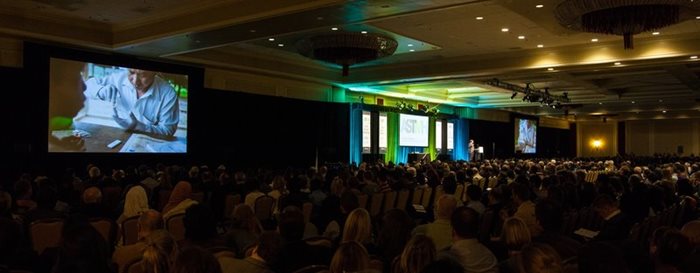Key Moments
Society Leaders Attend JITMM, Meet with AFRIMS in Thailand,
December 7-9, 2016
 |
From left, Watcharapong Piyaphanee, Nalinee Chongviriyaphan, Patricia Walker and Karen Goraleski
|
President Patricia F. Walker, MD, DTM&H, FASTMH, past President Christopher V. Plowe, MD, MPH, FASTMH, and Executive Director Karen A. Goraleski held a symposium at the Joint International Tropical Medicine Meeting 2016, December 7-9 in Bangkok, Thailand.
Titled “Thailand and ASTMH – a Shared Vision in Tropical Medicine,” presentations included Human Mobility and Health, The Science and Politics of Malaria Elimination in the Greater Mekong Subregion, and ASTMH: Leveraging the Voices of Scientists for Change by Dr. Walker, Dr. Plowe and Ms. Goraleski, respectively. The symposium was co-chaired by member Watcharapong Piyaphanee, MD and Dr. Walker.
“We were honored to be with our international colleagues. We have learned so much through our wonderful partnership with Mahidol University’s Faculty of Tropical Medicine, our Asian Clinical Tropical Medicine Course, partnerships with CDC GeoSentinel Sites in Chiang Mai and Bangkok, and many research collaborations in the region."
In 2016, the Society’s international members accounted for 35% of total membership, representing 112 countries.
View Dr. Walker's slides here.
View Dr. Plowe's slides here.
View Ms. Goraleski's slides here.
 |
AFRIMS meeting deepens Society’s commitment to military Trop Med
President Walker, past President Plowe and Executive Director Goraleski also visited the Armed Forces Research Institute of Medical Sciences, Thailand. Here, the U.S. Army Medical Research and Materiel Command and WRAIR, guests of the Royal Thai Army, work hand in hand. Research activities are collaborative and include a focus on infectious diseases of military and public health importance to the region.
"Spending the day with senior AFRIMS leadership and staff and the Royal Thai Army AFRIMS in Bangkok was truly inspiring,” Dr. Walker said. “We will continue to emphasize the importance of collaborating with and funding our Department of Defense colleagues who are providing such ground-breaking research and development in tropical medicine and global health."
AFRIMS has been a joint Thai-American medical research venture since 1958. It develops products to detect, prevent and treat diseases where there is little financial incentive. Its enduring contributions to global health include research on Japanese Encephalitis and Hepatitis A vaccines and dengue vaccine Phase 3 trials, as well as participation in the discovery or development of most U.S.-FDA approved anti-malarials.
“Strong science and strong partnerships with the Thai military and community are shining examples of global respect and a model for more such U.S. partnerships,” Ms. Goraleski said.
Sixth Annual "ASTMH in Peru," March 21-23, 2016, Lima, Peru
 |
From left, Willy Lescano, Gisela Orjeda, Stephen Higgs and Karen Goraleski.
|
More than 225 attendees from 14 countries in the Americas and Europe attended the 6th annual “ASTMH in Peru.” This year’s meeting was celebrated in tribute to the late Alan J. Magill, MD, FASTMH, past president of ASTMH and a key leader in the formation of ASTMH in Peru. Held at the new Lima Convention Center, the event was organized by ASTMH member Willy Lescano, PhD, MHS, MHS, and a consortium of five Peruvian organizations: (Peruvian) National Institute of Health (INS), Peruvian Society of Infectious and Tropical Diseases (SPEIT), “Alexander von Humboldt” Tropical Medicine Institute of Universidad Peruana Cayetano Heredia (IMT AvH), “Daniel A. Carrión” Tropical Medicine Institute of the Universidad Nacional Mayor de San Marcos (IMT DAC), and Emerge, the Research Unit and Training Program in Emerging Diseases and Climate Change.
 |
 |
ASTMH in Peru was established to further disseminate Peru-driven research (abstracts and posters) presented at the ASTMH Annual meeting. This partnership enables local researchers and trainees unable to attend the U.S. meeting to hear the latest research directly from their colleagues and in Spanish. The 2016 three-day meeting opened with a keynote speech by ASTMH President Stephen Higgs, PhD, FRES, FASTMH, who also later provided an update on the Zika epidemic. Karen A. Goraleski, ASTMH Executive Director, gave a thought-provoking presentation on communicating science to the public. Daniel G. Bausch, MD, MPH&TM, FASTMH, ASTMH Scientific Program Committee Chair, led sessions on the response to the Ebola epidemic and febrile hemorrhagic viruses. Gisela Orjeda, PhD, President, CONCYTEC (Peru’s National Council for Science, Technology and Technological Innovation), presented an update on science and technology developments in Peru. The conference also included three pre-meeting courses on grant writing, manuscript preparation and clinical skills.
Click here to view the slides from Stephen Higgs' keynote address.
To view the slides from Stephen Higgs' update on Zika, click here.
Fifteen oral and 67 poster presentations addressed topics including malaria, leishmaniasis, cysticercosis, dengue, Zika, Ebola, enteric and respiratory diseases. Two bridge sessions between experienced researchers and public health practitioners served to establish a link between research and practice, proposed potential public interventions and identified research questions of interest for the public sector. A “Meet the Research Institutions” allowed attendees to meet investigators from different groups and learn more about their research areas. In addition, ASTMH leaders had an informal conversation with young ASTMH members on how the Society can better support this growing Latin American constituency. One suggestion has already been implemented: highlighting two AJTMH articles each month on the ASTMH Facebook page (the go-to page for many younger members).
Click here to view the slides (in Spanish) from Gisela Orjeda's update on science and technology development in Peru.
The meeting closed with personal tributes to Alan Magill, a beloved supporter of tropical medicine efforts in Peru. Eight speakers – four from Peru – shared memories and photos of how their lives and careers were touched by this giant of tropical medicine. Alan will continue to be present in Peru every year through what is now becoming ASTMH in Latin America.
"ASTMH in Kenya," February 9, 2016, Kenya, Africa
 The first "ASTMH in Kenya" meeting took place on February 9 in Nairobi, and signaled a new partnership between ASTMH, our Kenyan colleagues at the Kenya Medical Research Institute (KEMRI) and the KASH conference. ASTMH President Stephen Higgs, PhD, FRES, FASTMH, delivered the opening keynote address and ASTMH Councilor Serap Aksoy, PhD, FASTMH, hosted a writing workshop that elicited a robust discussion on the challenges and barriers to publishing. ASTMH in Kenya preceded the 6th KEMRI Annual Scientific and Health (KASH) Conference on February 10-11.
The first "ASTMH in Kenya" meeting took place on February 9 in Nairobi, and signaled a new partnership between ASTMH, our Kenyan colleagues at the Kenya Medical Research Institute (KEMRI) and the KASH conference. ASTMH President Stephen Higgs, PhD, FRES, FASTMH, delivered the opening keynote address and ASTMH Councilor Serap Aksoy, PhD, FASTMH, hosted a writing workshop that elicited a robust discussion on the challenges and barriers to publishing. ASTMH in Kenya preceded the 6th KEMRI Annual Scientific and Health (KASH) Conference on February 10-11.
View the slides from President Stephen Higgs' keynote address here.
.jpg?width=300&height=225) |
 |
 |
 |
| Stephen Higgs (left) with Pauline Mwinzi, Chair, KASH Committee, and Principal Scientist, NTD Department, Kenya Medical Research Institute (KEMRI). |
Stephen Higgs, Serap Aksoy, and
longtime ASTMH member W. Evan
Secor.
|
The meeting showcased Kenyan-driven research, including abstracts and posters, presented at the ASTMH Annual Meeting last October in Philadelphia. Through this partnership, local scientists unable to attend the ASTMH meeting in the U.S. were able to hear the latest research directly from their colleagues who presented at TropMed15. Twenty-five abstracts were presented. ASTMH in Kenya drew about 150 people attending both the scientific sessions and writing workshop.
Watch KASH Committee Chair Pauline Mwinzi discuss ASTMH in Kenya here.
 |
| From left, Karen Goraleski, ASTMH Executive Director; Stephen Higgs; Serap Aksoy; and W. Evan Secor. |
.jpg?width=234&height=300) |
|
|
|
 |
| Stephen Higss (left) presents an award to Edwin K. Bett, Monitoring and Evaluation Officer, KEMRI |
|
|
|
Karen Goraleski (left) presents a certificate to Peter Mwitari, KEMRI |
 |
|
|
|
|
| Karen Goraleski (left) presents a certificate to Elizabeth Kendi |
|
|
|
|
In addition, eight young investigators submitted articles specifically for the ASTMH Young Investigator Award competition.
.jpg?width=166&height=250) |
|
.jpg?width=229&height=250) |
| Stephen Higgs (left) presents a Young Investigator Award to Rosaline Macharia |
|
Stephen Higgs (left) presents a Young Investigator Award to Gathii Kimita |
| |
 |
|
 |
| |
Stephen Higgs (left) with a guest at "ASTMH in Kenya." |
|
Stephen Higgs (left) with Sultani Hadley Matendechero, Head of Neglected Tropical Diseases Unit, Ministry of Health, Kenya |
| |
|
|
 |
Replica Ebola Treatment Unit, October 25-29, 2015, Philadelphia, PA
This 2015 Annual Meeting in Philadelpha offered attendees a chance to briefly step into the large black boots of people who staffed the Ebola Treatment Units (ETU) during the 2014 outbreak. A replica ETU provided a sense of what it was like to put on personal protective equipment (PPE) and care for patients in a warm environment, simulated with heat lamps and activities like playing Jenga and sorting Tic Tac candies.
“The ETU was one of the many exciting facets at this year’s ASTMH meeting in Philadelphia,” said Scientific Program Chair Daniel G. Bausch, MD, MPH&TM, FASTMH. “Visitors were able to try on PPEs to get an idea of the challenge of working in this setting. We staffed the ETU with on-the-groud experts who shared their stories and answered questions. Given the diversity of meeting attendees, the replica ETU definitely added a new educational experience for many.”
Myanmar Forum, August 2-4, 2015, Washington, DC

Dr. Khine Zar Win, Myanmar Ministry of Health; Dr. Myaing Myaing Nyunt, University of Maryland Institute for Global Health; Dr. Nu Nu Tha, Myanmar President's Office; Dr. Thein Thein Htay, Myanmar Ministry of Health; Eh Kalu Shwe Oo, Karen Department of Health and Welfarel. Second row: Saw Tamala Khin, Karen Department of Health and Welfare; Dr. Aung Moe Nyo, member of the Union Parliament, representing the National League for Democracy; Dr. Tin Myo Win, Myanmar Parliament; Dr. Nay Lin, Myanmar Parliament; Dr. Kyaw Zin Thant, Myanmar Ministry of Health; Sai Laeng, Shan State Development Foundation)
Under the leadership of ASTMH President Chris Plowe, the Society along with the Center for Strategic and International Studies and the Institute for Global Health at the University of Maryland School of Medicine convened an historic gathering on August 2-4, 2015 in Washington, DC that reached across political and ethnic divides with a shared vision to of eliminating malaria in Myanmar.
The meeting included senior officials from the Myanmar government, opposition, and minority communities including Myanmar’s office of the President, the Ministry of Health, Myanmar military medical experts, members of Parliament, the main opposition party, the National League for Democracy; and the Shan, Karenni, and Kayin ethnic minorities. This unprecedented dialogue also featured the main external partners actively supporting scientific research, capacity building, and evolving malaria control activities in Myanmar. These included the U.S. government, including the President’s Malaria Initiative, U.S. Pacific Command, CDC, NIH and Uniformed Services University of the Health Sciences; the World Bank; The Global Fund to fight AIDS, tuberculosis and malaria; the Bill & Melinda Gates Foundation; and the Asia Pacific Leaders Malaria Alliance. The U.S. Ambassador to Burma, the Myanmar Ambassador to the United States, and the World Health Organization each offered active support and guidance to the conference.
A conference statement summarizes key points of consensus from the August 3 event. "By coming together in good faith in Washington, DC, to commit to working collectively to eliminate malaria, the diverse Myanmar participants and their scientific, public health, and development partners illuminated one very powerful reality: eliminating malaria in Myanmar has the potential to unify Myanmar society and serve as a catalyst for social change," the conference statement notes.
ASTMH Press Release
Myanmar Conference Statement
CSIS Press Briefing: Eliminating Malaria in Myanmar
Lancet: Myanmar given an international boost to eliminate malaria
BMJ: Myanmar ministers and opposition leaders agree plan to eliminate malaria by 2030
Roll Call: Malaria as a Catalyst for Change in Myanmar: Commentary
Remarks from The Honorable Derek Mitchell, U.S. Ambassador to Burma
ASTMH Science Diplomacy: Q&A with Chris Plowe and Myaing Nyunt
Fifth Annual "ASTMH in Peru," February 18 – 19, 2015, Lima, Peru
 Six years after the idea was first posed by Peruvian researchers as a way to make the Peruvian-driven science presented at the Annual Meeting accessible to local colleagues unable to attend the meeting in the U.S., the recent fifth "ASTMH in Peru" drew 480 researchers from Peru and surrounding countries. On February 18-19, 2015, in Lima, researchers, students and trainees gathered to hear oral presentations, view posters, listen to keynote speakers and new this year, attend pre-meeting courses (126 attended). Chile, Colombia, Ecuador and Brazil were represented this year increasing opportunities for South–South networking.
Six years after the idea was first posed by Peruvian researchers as a way to make the Peruvian-driven science presented at the Annual Meeting accessible to local colleagues unable to attend the meeting in the U.S., the recent fifth "ASTMH in Peru" drew 480 researchers from Peru and surrounding countries. On February 18-19, 2015, in Lima, researchers, students and trainees gathered to hear oral presentations, view posters, listen to keynote speakers and new this year, attend pre-meeting courses (126 attended). Chile, Colombia, Ecuador and Brazil were represented this year increasing opportunities for South–South networking.
The event has grown each year: posters increased 31%, orals by 30%, and attendance was up 21%. Multiple Peruvian organizations and research leaders are involved in the success of this event, with ASTMH member A. Roxana Lescano, JD, NAMRU-6 serving as the driving force. The Society applauds this innovative Peruvian-driven forum and looks forward to its replication in other parts of the world.
Fifth Annual ASTMH in Peru Conference Agenda
Bill Gates' Keynote Address, ASTMH Annual Meeting, November 2, 2014, New Orleans, LA
The Society was honored to have Bill Gates deliver the keynote address at its 2014 Annual Meeting to a packed room of more than 3,000 and two "overflow" rooms with video screens. Earlier in the day, Gates dropped in on the Young Investigator Award competition and spoke with some of the investigators about their presentations. Later, he enjoyed an informal Q&A with the ASTMH Council. In his speech, Gates announced a 30 percent increase in the Foundation’s already sizeable commitment to fighting malaria. In an announcement coinciding with the speech, the Foundation said a total of $500 million in new spending overall would be allocated to reducing the burden of infectious disease in the developing world.
 |
 |
| |
Bill Gates (left) with 2014 ASTMH President Alan J. Magill, MD, FASTMH |

Watch the video of Bill Gates' Keynote Address at the 2014 ASTMH Annual Meeting in New Orleans, LA
Fourth Annual "ASTMH in Peru," February 19, 2014, Lima, Peru
 The Society's Peruvian colleagues convened another successful ASTMH Peru Annual Conference in Lima on February 19, 2014. Held for the fourth consecutive year, with increasing attendance each year, 2014’s event attracted 388 attendees – mostly from Peru, a few from the United States and two from Brazil.
The Society's Peruvian colleagues convened another successful ASTMH Peru Annual Conference in Lima on February 19, 2014. Held for the fourth consecutive year, with increasing attendance each year, 2014’s event attracted 388 attendees – mostly from Peru, a few from the United States and two from Brazil.
ASTMH Peru is organized annually by the U.S. Naval Medical Research Unit No. 6 (NAMRU-6). It provides those Peruvian investigators who had presentations and posters at the ASTMH Annual Meeting in the U.S. the opportunity to present their research to local colleagues in their native language. Funds raised at the Peruvian event are put towards a scholarship for local researchers to attend the ASTMH Annual Meeting. Since the initial ASTMH Peru, six Peruvian scientists have travelled to the U.S. on these scholarships.
Richard Oberhelman, MD, president of the Society’s Clinical Group, delivered the keynote presentation, focusing on international collaborative training grants.
The following sponsors supported this year’s event: Instituto Nacional de Salud, Peruvian Society of Infectious and Tropical Diseases (SPEIT), Instituto de Medicina Tropical “Alexander Von Humboldt” – Universidad Peruana Cayetano Heredia (IMT AvH), the Instituto de Medicina Tropical “Daniel A. Carrión” - Universidad Nacional Mayor de San Marcos (IMT DAC) and the Peru Infectious Diseases Epidemiology Research Training Consortium. The event was partially funded by the Consejo Nacional de Ciencia y Tecnología del Perú, CONCYTEC.
Fourth Annual ASTMH in Peru Conference Agenda (English)
Fourth Annual ASTMH in Peru Conference Agenda (Spanish)
Third Annual "ASTMH in Peru," February 13, 2013, Lima, Peru
The third annual ASTMH Meeting in Peru was held in Lima on February 13, 2013, and provided a venue for Peruvians to see and hear their colleagues’ research that was presented at the 2012 Annual Meeting in Atlanta, GA. Last year, 59 Peruvians presented research at the meeting. With more than 350 attendees from all regions of Peru this conference is an increasingly valuable way to network with colleagues in-country and extend the scientific knowledge from the Annual Meeting even further.
As the meeting got under way, Alejandro Llanor-Cuentas, president of SPEIT, welcomed attendees, while Cesar Cabezas, director of INS, provided inaugural comments. This was followed by 20 oral presentations and an energetic poster session.
President-Elect Alan Magill, MD, FASTMH, delivered an evening plenary address, "Accelerating to Zero: An Analytic Framework for Malaria Eradication," in which he cited examples from his past malaria research in the Peruvian Amazon. The evening concluded with comments from Eduardo Gotuzzo, director of the Insituto Medicina Tropical and an Honorary International Fellow of ASTMH, and ASTMH Councilor Dan Bausch MD, MPH&TM.
Throughout the day, the real energy and excitement among attendees was palpable – especially from the students and trainees. In addition to facilitating one-on-one connections, the meeting provides a helpful opportunity to establish collaboration and partnerships between Peruvian institutions.
This ASTMH-Peru collaboration is a uniquely grassroots effort and the brainchild of our Peruvian colleagues. Peruvians organize and fund the meeting completely. It is an exemplary model that showcases the impressive science conducted by our international members.
Partners for the meeting included: ASTMH, Centro de Investigación de Enfermedades Tropicales - NAMRU-6, Instituto de Medicina Tropical “Alexander von Humboldt” – Universidad Peruana Cayetano Heredia (UPCH), Instituto de Medicina Tropical “Daniel A. Carrión” – Universidad Nacional Mayor de San Marcos (UNMSM), Instituto Nacional de Salud (INS), Programa de Entrenamiento 2D43-TW007393, NIH/FIC, and Sociedad Peruana de Enfermedades Infecciosas y Tropicales (SPEIT).
Second Annual "ASTMH in Peru," February 16, 2012, Lima, Peru
 The second annual ASTMH and Peru collaboration took place February 16, 2012, at the Auditorium of the College of Physicians in Lima. This collaboration featured the presentation in Spanish of Peruvian research offered at the ASTMH Annual Meeting in Philadelphia in December 2011. The attendance of 324 was nearly double last year’s participation. The conference included 13 oral and 43 poster presentations and featured a "Meet the Professor" session similar to one presented in Philadelphia. Topics focused on health issues relevant to Peru and the Americas, namely malaria, leishmaniasis, cysticercosis, dengue fever, enteric disease and others.
The second annual ASTMH and Peru collaboration took place February 16, 2012, at the Auditorium of the College of Physicians in Lima. This collaboration featured the presentation in Spanish of Peruvian research offered at the ASTMH Annual Meeting in Philadelphia in December 2011. The attendance of 324 was nearly double last year’s participation. The conference included 13 oral and 43 poster presentations and featured a "Meet the Professor" session similar to one presented in Philadelphia. Topics focused on health issues relevant to Peru and the Americas, namely malaria, leishmaniasis, cysticercosis, dengue fever, enteric disease and others.
Society Councilor Dan Bausch, MD, MPH&TM, provided an overview of the clinical features of Hantavirus infections, transmission mechanisms and geographic distribution, explaining how changes in distribution, population density, prevalence of infection and pathological burden contribute significantly to increased risk of zoonotic diseases by favoring the dissemination of opportunistic species, such as hantaviruses. ASTMH's Alan Magill, MD, FACP, FIDSA, FASTMH, highlighted the proud history of the Peruvian research community in the field of tropical and infectious diseases and encouraged more scientists to continue to present their work in international venues.
AJTMH Editor-in-Chief Joe Vinetz, MD, FASTMH, offered his insights into the journal publication process. With 11 percent of AJTMH papers submitted from South American authors, Vinetz explained how authors can improve their chances of being published in a high-impact journal like AJTMH. He also spoke of the importance of being published in an English-language journal, but indicated that language should not be a barrier to seeking publication.
The ASTMH and Peru Partnership was organized by the U.S. Naval Medical Research Unit No. 6 (NAMRU-6), with the sponsorship of the Instituto Nacional de Salud, Peruvian Society of Infectious and Tropical Diseases, Instituto de Medicina Tropical "Alexander von Humboldt"-Universidad Peruana Cayetano Heredia, Instituto de Medicina Tropical "Daniel A. Carrion"-Universidad Nacional Mayor de San Marcos and the Peru Infectious Diseases Epidemiology Research Training Consortium.
Second Annual ASTMH in Peru Conference Agenda (English)
Second Annual ASTMH in Peru Conference Agenda (Spanish)
First "ASTMH in Peru," February 16, 2011, Lima, Peru
 ASTMH, in partnership with our colleagues in Lima, Peru, held the first joint conference sharing scientific information that was presented at ASTMH's 59th Annual Meeting in November 2010 in Atlanta, Georgia, USA.
ASTMH, in partnership with our colleagues in Lima, Peru, held the first joint conference sharing scientific information that was presented at ASTMH's 59th Annual Meeting in November 2010 in Atlanta, Georgia, USA.
The February 16, 2011, conference, at the "Daniel A. Carrión" Convention Center, Peruvian Medical Board of Physicians in Miraflores, attracted 205 attendees and featured 45 posters and 11 oral presentations in two tracks, focusing on research groups and manuscript writing. Honorary ASTMH member Dr. Eduardo Gotuzzo Herencia gave the opening presentation, highlighting the long history between Peru and the Society.
ASTMH member Alan Magill, MD, FACP, FIDSA, provided this first-hand report:
I was honored to represent the Society at the first ASTMH/Peru conference.
Our Peruvian colleagues have historically been active at the ASTMH annual meetings and have been responsible for scores of high-quality presentations. Peru is home to strong national and university-based research groups, many with very strong ties to American universities, such as the Johns Hopkins Bloomberg School of Public Health, the University of California-San Diego, the Centers for Disease Control and Prevention, and others.
I had the great privilege to live and work in Peru from 1996-2000 as the Head of Parasitology at the (then-) Naval Medical Research Center Detachment. It was during these formative years that I developed lasting friendships, continued research partnerships and acquired a changed world view about how research can help create partnerships between resource-rich non-endemic countries and our colleagues in countries with fewer resources.
As ASTMH has grown over the last decade, becoming the international meeting of choice for investigators, policy-makers and large funders and donors from around the world, its success is due in part to the support we have received from our international colleagues such as those in Peru.
This first meeting received great reviews from attendees and presenters alike, and we hope that the event represents a new path forward for growth for the ASTMH.